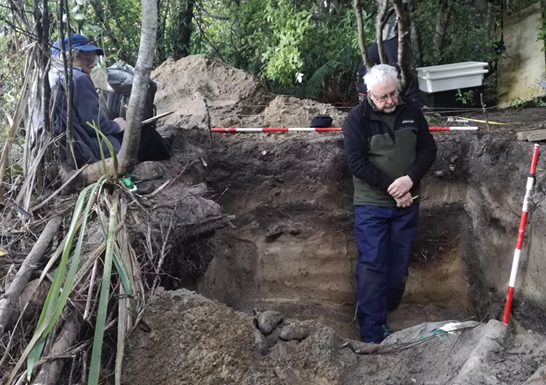Coastal Heritage Sites at Risk
Coastal Heritage Sites at Risk
 Brooke Tucker and Professor Atholl Anderson examine site stratigraphy during an excavation to salvage eroding archaeological material on Whenua Hou/Codfish Island. Photo: Johannes FischerCoastal movement and erosion are serious issues for the preservation and management of cultural heritage in this country. Numerous archaeological sites throughout New Zealand, particularly areas of first settlement, are situated on coastlines and at estuaries and river mouths. Over the last two decades, Brooke Tucker (currently an archaeology PhD candidate at the University of Otago) has worked on many coastal sites where pre-contact Māori archaeology has been exposed and damaged by erosion.
Brooke Tucker and Professor Atholl Anderson examine site stratigraphy during an excavation to salvage eroding archaeological material on Whenua Hou/Codfish Island. Photo: Johannes FischerCoastal movement and erosion are serious issues for the preservation and management of cultural heritage in this country. Numerous archaeological sites throughout New Zealand, particularly areas of first settlement, are situated on coastlines and at estuaries and river mouths. Over the last two decades, Brooke Tucker (currently an archaeology PhD candidate at the University of Otago) has worked on many coastal sites where pre-contact Māori archaeology has been exposed and damaged by erosion.
Integrating cultural and environmental management practices in coastal landscapes can be mutually beneficial. As the archaeologist for the Whenua Hou Diving Petrel project (run by Johannes Fischer, Victoria University of Wellington), Brooke has recently been monitoring dune movement on Whenua Hou/Codfish Island where erosion threatens both the diving petrel colony and several previously recorded archaeological sites. This work identified accelerated erosion (both tidal and riverine) at a significant archaeological site on the island. In September 2019 a salvage excavation took place, revealing several layers of both pre-contact and historic occupation and dense deposits of archaeological material. Analysis of this rescued material will contribute to our understanding of New Zealand’s past.
Posted: 14 November 2019 in the News category
